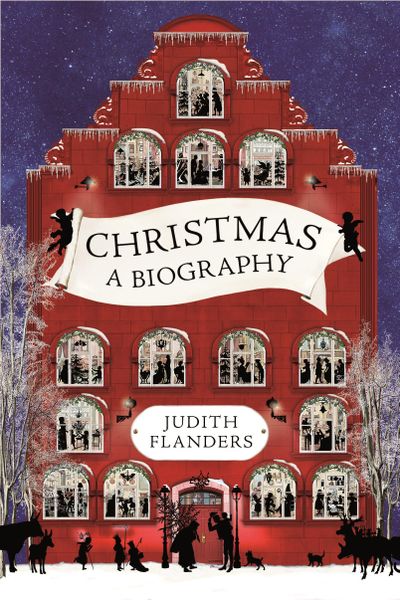Book World: Gold? Myrrh? A history of Christmas commercialism.

As Bing Crosby, Johnny Mathis and innumerable others might croon, “It’s beginning to look a lot like Christmas.” But what, precisely, does Christmas look like? In particular, is it a holy day or a holiday?
In “Christmas: A Biography,” social historian Judith Flanders questions the widespread assumption that “a deeply solemn religious event” has been “sullied” by our own secular, capitalist society. “From nativity to church, to family, to commerce” goes the commonly held view of the season’s history, “a story of high beginnings, a cosy, warm middle and the chill of cold cash at the end.”
This hardly matches the facts, as Flanders repeatedly shows: Yuletide has almost always been more rowdy and secular than reverent or religious.
Flanders begins with the background of Christmas festivities. First off, forget the Druids: “No convincing evidence of winter solstice celebrations in pagan Europe has survived.” However, Mithraism – the most popular pre-Christian religion of the Roman Empire – did honor the solstice as “the birth day of the unconquered sun” when Mithras “emerged from his birth place in a cave, witnessed by two shepherds.” Early Christian leaders apparently recognized that because many converts were used to commemorating that day, it made sense to co-opt it, even though Christ was probably born sometime in spring or summer.
Throughout the Middle Ages, the Christmas season was always a time of feasting, drinking and carnival, when social and sexual hierarchies were flouted and overturned. A spirit of Mardi Gras prevailed. Various lords of misrule and “wild men” oversaw the merrymaking, and wassailers drank one’s health in exchange for food or money. In the Renaissance, some Protestant denominations, such as Scotland’s austere Kirk, high-mindedly “declared all of Christmas a nasty popish invention and banned the holidays entirely.” During England’s Civil War, the more fanatical reformers labeled any festivities “a mark of the antichrist.” Nonetheless, such strictures were widely ignored, especially in rural areas, where Christmas was welcomed with greenery and mistletoe.
About the same time, in the Netherlands, St. Nicholas began to give small presents to good children, while “his Moorish helper, Zwarte Piet” – Black Peter – administered punishment to the bad. In Switzerland, the gift bringer was called Samichlaus, “Swiss-German for Sankt Klaus, that is, Niklaus.” By the end of the 17th century, the English were already singing some of our most famous carols: “Deck the Halls With Boughs of Holly,” “The First Nowell,” “God Rest You Merry, Gentlemen,” “We Wish You a Merry Christmas.”
Over in the American colonies, high-spirited young men fired off guns on Christmas Eve and spent the next day in taverns. As Flanders writes, “One Boston newspaper in 1735 took it for granted that men would ‘keep drunk all the Christmas Holy-Days,’ given the opportunity.” Gift-giving gradually increased, especially of books, although these could be gimmicky and vulgar.
In the late 18th and early 19th centuries, antiquarian nostalgia for the imagined customs of Merrie Olde England, along with popular works by contemporary writers, began to transform Yuletime into an intimate family affair. Washington Irving depicted a festive Christmas of dancing, roast beef and mince pies at Bracebridge Hall; in an influential essay, the poet Coleridge lovingly described one German family’s feasting and bonhomie; and in 1822 Clement Clarke Moore produced his bedtime classic, “A Visit From St. Nicholas.” By the time of “A Christmas Carol” (1843), Dickens was celebrating Victorian consumerism as much as Christian charity: “Cooking the turkey, playing games, drinking toasts, or buying a toy for your child … became the quasi-religious observances of the new middle-class domesticity.”
From this point on, “Christmas: A Biography” grows increasingly sociological, just as the holiday itself grows increasingly oriented toward children. Flanders writes about political cartoonist Thomas Nast’s depiction of Santa Claus, the rise of department store parades, the famous Christmas truce during World War I (inaugurated by the Germans, by the way), the sending of Christmas cards and the development of holiday wrapping paper.
Did you know that “Jingle Bells” – originally titled “The One Horse Open Sleigh” – was written by James Pierpont, uncle (and namesake) of the banker J.P. Morgan? Or that most of the 20th century’s hit Christmas songs were the work of Jewish composers? Little escapes Flanders’ notice, as she reflects on the film “It’s a Wonderful Life,” the nation-binding importance of Britain’s annual carol concert from King’s College, Cambridge, or the financial dependence of local ballet companies on performances of “The Nutcracker.” Throughout, too, her writing remains brisk and witty: She alludes to the seasonal tradition of reading ghost stories, “while the children break their new toys around you.”
In the end, Flanders stresses, Christmas is “a holiday that shape-shifts, that transforms itself, to become what we – our cultures – need it to be at any given time.” Its annual return “allows us an illusion of stability, of long-established communities, a way to believe in an imagined past, when it was safe for children to play in the street, when no one locked their doors and everybody knew their neighbours, all the while unconsciously omitting the less desirable parts of those times.” In short, our Christmas rituals honor “not the lives we have, but the lives we would like to have, in a world where family, religion, personal and social relationships are built on firm foundations.” Even though that world never really existed, the true magic of the holiday season is that “by repeating the rituals, we can go back there every year.” Merry Christmas!